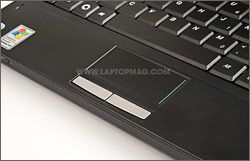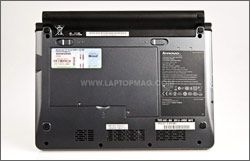Laptop Mag Verdict
Lenovo's popular netbook, repackaged for the education market, offers an instant-on OS and nearly five hours of battery life.
Pros
- +
Stylish, understated design
- +
Good battery life
- +
Fast hard drive
- +
Quick Start OS boots quickly
Cons
- -
Awkwardly placed right Shift key
- -
Noisy hard drive
- -
Only two USB ports
- -
Below-average graphics performance
Why you can trust Laptop Mag
Lenovo's IdeaPad S10e isn't just the S10 rebranded for the education market; it offers some features its successful predecessor doesn't, including a Quick Start OS and a long-lasting six-cell battery. If you're charged with buying a notebooks for a K-12 one-to-one laptop program or want a secondary computer for the home that the kids can use, the S10e, at $429, is a strong contender.
Design
Although aimed at children, the S10e has a design mature enough to appeal to grown-ups. The lid comes in an understated gunmetal gray, and although glossy, it doesn't pick up smudges. Inside, the chassis, keyboard, and palm rest are all matte black, but turquoise and white accents on the keys keep the system from looking dull.
At 2.8 pounds, the S10e is the same weight as theMSI Wind U120but 0.1 inches thicker. Particularly compared with theCTL 2Go Convertible Classmate PC, a 3-pound tablet with a handle and 1.5-inch-thick chassis, it seems svelte. Even with the six-cell battery jutting out slightly in the back, the 9.8 x 7.7 x 0.9-1.4-inch S10e was easy to hold in the crook of our arm.
Keyboard and Touchpad
The keyboard stretches almost all the way across the 7.7-inch-wide chassis, with little room to spare on the sides. Even for our adult hands, the layout was large enough; we were able to score 83 words per minute on the online typing test Ten Thumbs (we scored 88 words per minute when we took the same test on our desktop computer). The keyboard showed visible flex, but in general the keys had a nice, springy feel.
The biggest turnoff on the S10e is the shrunken right Shift key, which is located to the right of the up arrow. We much prefer

Click to enlargenetbooks with layouts that position the right shift key to the left of the up arrow--such as on theHP Mini 1000and MSI Wind U120 --so you don't accidentally move up a line when you intend to capitalize a letter.
Although the touchpad is tiny, measuring 2.3 by 1.1 inches , it felt large enough for dragging the cursor across the screen. But when we used two fingers to pinch and expand Web pages using the S10e's multitouch capability, we craved more room. Plus, Web pages looked a bit jerky as they resized themselves. The two discrete metal touch buttons were easy to press, but on the loud side.
Ports and Webcam

Click to enlarge
Like the original S10, the S10e has two USB ports, a VGA port, an Ethernet jack, an ExpressCard/34 slot, a 4-in-1 memory card reader, and a Kensington lock slot built into the hinge. The ExpressCard slot is a bonus because it allows for a mobile broadband connection card with a lower profile than USB-connected ones. Some education buyers might pooh-pooh the relative shortage of USB ports, but most netbook users aren't likely to schlep along lots of peripherals anyway.
The S10e also has a 1.3-megapixel webcam, which looked smooth enough but didn't fare well in harshly lit situations (our fluorescent-lit office, for example).

Click to enlarge

Click to enlarge
Display and Sound
The S10e's 10.1-inch screen looked bright, although the 1024 x 576-pixel resolution was too low for our tastes; other netbooks have a resolution of 1024 x 768 or 1024 x 600 pixels. Having less pixels running lengthwise down the screen on this system means more scrolling while viewing Web pages and documents.
The speaker strip, located above the keyboard, isn't the loudest, of course, but it was sufficient for listening to Hulu and YouTube clips in a quiet room.
Lenovo's Quick Start
The S10e is one of the first IdeaPads to include Quick Start, Lenovo's version of Splashtop, the instant-on OS, which boots faster than Windows XP, the netbook's primary operating system. Just press the power button and the computer will boot into Quick Start (you can disable Quick Start in the settings if you'd rather boot directly into XP). Within seconds you'll have access to your music, photos, Skype, chat clients, and a pared-down Web browser based on Mozilla Firefox.
When Quick Start first loads, you'll see a ten-second countdown on-screen: if you don't start using Quick Start's features in that time, the computer will automatically start booting XP. At any time, you can press one of two on-screen buttons to either shut down or switch to XP. Note that XP does not load in the background: when you switch to XP you'll have to watch it load.
Overall, we like the calming brown and gray Quick Start interface with the large, colorful icons denoting the different features. On our tests, it took 11 seconds to load (plus an additional 10 seconds to load the browser), which is fast compared with Splashtop machines (the ASUS N10Jc's Splashtop-based ExpressGate took 9 seconds to boot, and 30 to load the browser). Future S10 notebooks will have Quick Start, but with a different look: black with neon icons.
The browser doesn't support any add-ons, but it does allow for tabbed browsing, which is the most we think Web surfers will ask for in this kind of environment. We were even able to stream videos through both YouTube and Hulu.com. The chat portion lets users add accounts from AIM, Windows Live Messenger, Google Talk, and Yahoo Messenger.
Performance

Click to enlarge
Like many other netbooks on the market, the S10e runs on a single-core, 1.6-GHz Intel Atom N270 CPU. Our unit was configured with Windows XP Home and 1GB of RAM, but you can get it with 512MB of RAM or with a Linux-based OS and 1GB of RAM for $379 and $429, respectively.
Unfortunately, the S10e could not run PCMark05, owing to an incompatible screen resolution. That said, we were impressed with the machine's performance. It booted in 52 seconds, which is on the money for an XP netbook. Also, its 80GB hard drive transferred a 4.97GB mixed media folder in 5:05, which translates to a speed of 16.7 MBps, which is 3 MBps faster than the netbook average, though not quite as fast as the Samsung NC10 (17.4 MBps).
We also had no problem multitasking: we were able to download and install Skype and still surf the Web and read e-mail with ease. The trade-off for fast performance, though, is a noisy hard drive and fan. The drive spun loudly while it installed Skype, and even minutes later, while idle, the fan continued to whir.
The last time we reviewed the S10, we complained about its high temperatures, even when left idle. This time around, the S10e didn't feel uncomfortably hot.
Graphics Performance
The S10e's Intel GMA 950 integrated graphics card notched 745 on 3DMark03 (which measures DirectX 9 performance), and 90 on 3DMark06, which simulates more-graphically demanding games. That 3DMark03 score is about 60 points below average, which isn't terrible, but the 3DMark06 score is 154 points below the category average. Then again, given that this netbook performs well during everyday tasks and has a fast hard drive, its subpar gaming scores are hardly a deal breaker.
Wi-Fi and Battery Life
A Broadcom 802.11b/g wireless radio delivered throughput of 15.5 Mbps and 13.4 Mbps at 15 and 50 feet, respectively. In the grand scheme of things, those scores are good for an 802.11g radio (they'd be respectable for an 802.11n notebook, even), and are strong enough for simple Web surfing. Nevertheless, they fall below the category averages (17.9 Mbps and 14.3 Mbps at 15 and 50 feet).
The S10e's six-cell battery lasted 4 hours and 48 minutes on the LAPTOP Battery Test (continuous Web surfing over Wi-Fi). That's almost an hour longer than the category average, which includes netbooks with both three- and six-cell batteries (Lenovo's consumer-oriented S10, which, in our review, lasted 2 hours and 23 minutes with a three-cell battery, now has six-cell battery for an $89 premium). Nevertheless, category front-runners, such as the Samsung NC10 and HP Mini 2140, lasted well over 6 hours on a charge.
On the plus side, the S10e has aggressive power-management settings. We noticed that this Energy Star-approved netbook went to sleep just minutes after an idle period again; Energy Star's requirement is that notebooks go to sleep after no more than 15 minutes of idleness.
Software and Warranty
The S10e's software stack is fairly small, which is appropriate for the education market. Applications include Lenovo Energy Management, PC-Doctor 5 for Windows, ThinkVantage System Update, Windows Live Messenger, and Windows Live Photo Gallery. The system comes with a one-year parts-and-labor warranty, which is standard for the category and for notebooks in general. Click here to see how Lenovo fared in our Tech Support Showdown.
Verdict

Click to enlarge
The Lenovo IdeaPad S10e (starting at $379) is a good netbook that combines an attractive design and relatively fast hard drive with a compelling instant-on OS. We could do with less noise and a higher screen resolution, but otherwise we were happy with its performance. Parents and education buyers should still consider the CTL 2Go Convertible Classmate PC ($499) for younger students, but for students on the latter end of the K-12 spectrum, the $70 cheaper S10e is the way to go.
Lenovo IdeaPad S10e Specs
| Bluetooth | Bluetooth 2.1 |
| Brand | Lenovo |
| CPU | 1.6-GHz Intel Atom N270 |
| Card Slots | 4-1 card reader, ExpressCard |
| Company Website | http://www.lenovo.com/us |
| Display Size | 10.1 |
| Graphics Card | Intel GMA 950 |
| Hard Drive Size | 80GB |
| Hard Drive Speed | 5,400rpm |
| Hard Drive Type | SATA Hard Drive |
| Native Resolution | 1024x576 |
| Operating System | MS Windows XP Home |
| Ports (excluding USB) | VGA, Modem, Microphone, Headphone, Ethernet |
| RAM | 1GB |
| RAM Upgradable to | 1.5GB |
| Size | 9.8 x 7.7 x 1.4 inches |
| USB Ports | 2 |
| Video Memory | 512MB |
| Warranty/Support | One-year parts and labor/24/7 toll-free phone |
| Weight | 2.8 pounds |
| Wi-Fi | 802.11b/g |
Most Popular

